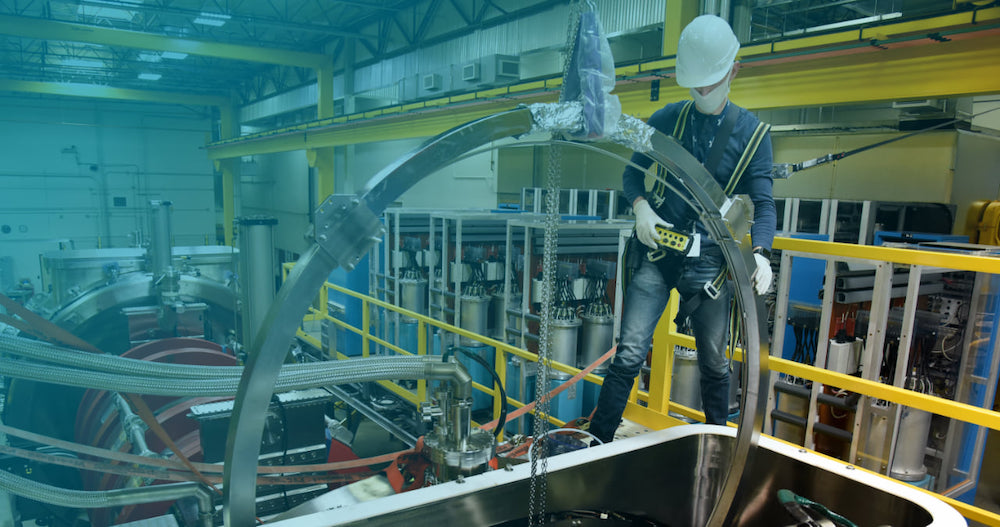Greetings, Agents of Impact!
Featured: ImpactAlpha Original
Long coming but slow to arrive, fusion energy approaches a milestone on the path to commercial deployment. In an old brick garage on an industrial street in Cambridge. Mass., a team of physicists and engineers are getting ready this month to flip the switch on a 10-ton magnet. The 40,000 amps of electricity spinning through hundreds of miles of superconducting tape will create a magnetic field able to contain a cloud of plasma at 180 million degrees, the temperature needed to fuse atoms – and throw off clean, abundant fusion energy. “That’s what you need to do to build this next fusion machine,” says Bob Mumgaard of Commonwealth Fusion Systems, a venture-funded startup spun out of MIT in 2018. This month’s magnet test is the key milestone in CFS’s plan to build, by about 2026, a fusion reactor that generates more power than the energy required to start the reaction, and commercial deployment in the early 2030s. Fusion has long been considered a holy grail – a scalable, carbon-free source of power without the drawbacks of other energy sources. But a viable fusion reactor has been 10 years away for decades – and still is. No fusion device has yet been able to generate “net energy.”
What’s different now is the more than two dozen venture-backed startups that have raised a combined $2 billion to commercialize fusion power from venture capitalists and investors like Bill Gates and Jeff Bezos. Orange County, Calif.-based TAE Technologies has raised more than $880 million. Canadian startup General Fusion has hauled in nearly $200 million. Zap Energy, in Seattle, raised $27.5 million in May. As in the race to map the human genome 20 years ago, the startups are competing with a global government-backed effort. The seven-nation International Thermonuclear Experimental Reactor, or ITER, under construction in the south of France, expects to produce net-energy fusion by about 2035. CFS’s audacious goal: 10,000 fusion power plants of around 200 megawatts apiece, located around the world – each one capable of powering a small city. Any plan to decarbonize the economy by 2050 relies on proven technology (think solar and wind) to halve carbon emissions by 2030. The second stage of decarbonization, through 2050, will require technology breakthroughs, Mumgaard tells ImpactAlpha. “We think that fusion could be a really great candidate for that.”
Keep reading, “Fusion energy approaches a milestone on the path to commercial deployment,” by Amy Cortese on ImpactAlpha.
Dealflow: High-Tech Logistics
Zipline secures $250 million for drone delivery in Africa, Japan and the U.S. Zipline launched its drone-delivery service five years ago to improve blood and medical-supply logistics in Rwanda. The California-based company is partnering with governments in Nigeria and Ghana on COVID vaccine delivery. In June, it began working with COVID-vaccine maker Pfizer to boost its vaccine cold-chain logistics. A $250 million Series E round, led by Baillie Gifford, will support Zipline’s expansion in Nigeria, Ghana, Rwanda, Japan and the U.S. The round values Zipline at $2.8 billion.
- U.S. expansion. Zipline made headlines in 2019 for raising $120 million, led by the Rise Fund, to expand from Africa to the U.S., where rural areas also struggle with access to healthcare products and services. Zipline last year provided personal protective equipment deliveries to health facilities in Africa and the U.S.
- Read on.
MaxAB raises $40 million to digitize Egypt’s mom-and-pop stores. Most of Egypt’s 100 million consumers buy staple products from small grocery stores and mom-and-pop retailers. MaxAB launched three years ago to “create a more cohesive, transparent and efficient food and grocery supply chain in Egypt.” The Cairo-based business-to-business e-commerce platform handles inventory sourcing, delivery, digital payments and access to credit for small food retailers. North Africa-focused impact investor RMBV led MaxAB’s Series A round. Also participating: the International Finance Corp., Flourish Ventures, Crystal Stream Capital, Rise Capital, Endeavor Catalyst, Beco Capital and 4DX Ventures.
- Digital inclusion. The pandemic highlighted the structure of Egypt’s economy, “with hundreds of thousands of shopkeepers and small businesses becoming the lifeline of our country at the time of crisis,” RMBV’s Ahmed Badreldin said. MaxAB supports more than 55,000 retailers and claims it has helped create 1,600 jobs.
- Check it out.
Dealflow overflow. Other investment news crossing our desks:
- Bridges Fund Management sells a majority stake in U.K.-based second-hand book retailer World of Books to private equity firm Livingbridge.
- OneWattSolar, Nigeria’s ‘Uber for energy services,’ issues an Islamic-finance compliant green bond to expand off-grid solar access in Africa.
- Nigerian fintech FairMoney raises $42 million to expand banking and lending services as a newly licensed microfinance institution.
- AllHere, a Black- and woman-led edtech company, scores $8 million to help U.S. schools improve attendance.
- GM’s philanthropic group launches a $25 million Climate Equity Fund to facilitate equitable adoption of electric vehicles and clean tech.
- The Rise Fund and Norfund commit $125 million to Indian solar energy company Fourth Partner Energy.
- California-based Fortera secures $30 million to convert CO2 into cement.
Impact Voices: Impact M&A
Scaling impact through nonprofit mergers and acquisitions. The pandemic couldn’t halt the merger of international non-profits Global Communities and Project Concern International, which shared values as well as complementary areas of expertise and geographic footprints. The rationale for the combination, finalized in April 2020, became even more compelling in the face of the COVID pandemic. The crises of the last year caused non-profit leaders to plan for contingencies in creative ways, including mergers and acquisitions. “The sector should build on this momentum,” write Dalberg’s Jeffrey Berger and Noah Elbot in a guest post on ImpactAlpha. “It is time to mainstream M&A planning as a key tool for scaling impact, not a rushed desperation measure.”
- Not a cure all. High up-front costs, poorly aligned field programs and culture clashes are all real risks for nonprofit mergers. Late-stage merger talks between Oxfam Ireland and Goal, for example, broke down following disagreements on how to combine programs.
- Mitigating risk. Funders and ecosystem actors can help de-risk organizational combinations. In the U.S., the Sustained Collaboration Network of funders and intermediaries is forming to fill this gap. Nonprofit boards often hesitate to discuss mergers, warn Berger and Elbot. “A ready plan for formal collaboration, including M&A, could make the difference in preserving or even scaling the mission.”
- Keep reading, “Scaling impact through nonprofit mergers and acquisitions,” by Jeffrey Berger and Noah Elbot on ImpactAlpha.
Agents of Impact: Follow the Talent
Heba Ali, ex- of Egypt Ventures, is named managing director of Endeavor Egypt… Generation Investment Management is hiring a growth equity analyst in London… Align Impact is looking for an investment analyst of private funds in Santa Monica, Calif… CapShift seeks a director of finance in Boston… Nonprofit Finance Fund is recruiting a manager of business development in Los Angeles or Oakland… Domini Impact Investments is hiring a senior marketing and shareholder communications associate in New York.
Thank you for your impact.
– July 6, 2021











